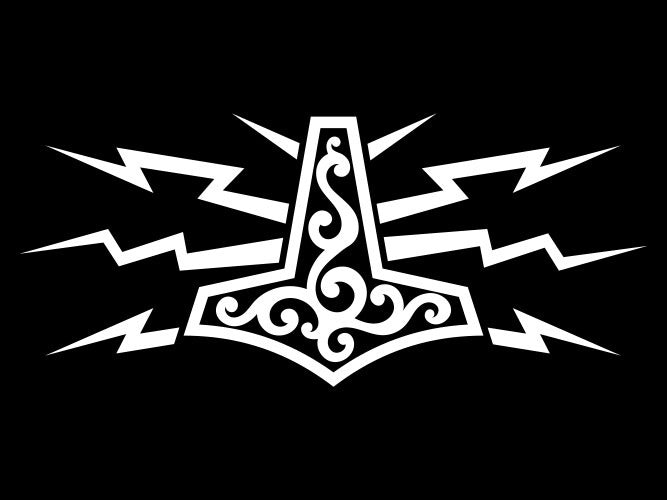Mjölnir: The Hammer of Thor and Symbol of Norse Power

Mjölnir, the legendary hammer of the Norse god Thor, is one of the most iconic symbols in Norse mythology. Known for its immense power, Mjölnir is not just a weapon but also a symbol of protection, blessing, and the power of the gods. Revered by the ancient Norse people and still popular in modern culture, Mjölnir represents the enduring legacy of the Viking Age and its warrior ethos.
The Mythological Origins of Mjölnir
In Norse mythology, Mjölnir was forged by the dwarven brothers Sindri and Brokkr, master craftsmen of the gods. The hammer was a gift to Thor, the god of thunder and protector of Midgard (the world of humans). Despite a slight flaw in its design—its handle being shorter than intended—Mjölnir became the most feared weapon in all the realms. It was said that with Mjölnir, Thor could summon lightning, thunder, and storms, and that the hammer was so powerful it could crush mountains.
Mjölnir was also imbued with magical properties that made it a versatile tool. It could shrink to fit inside Thor’s pocket, and when thrown, it would always return to his hand, ensuring that the god was never without his weapon. In addition to its destructive power, Mjölnir was used to consecrate marriages, bless births, and hallow the dead, making it a symbol of life, death, and everything in between.
Thor and the Role of Mjölnir in Norse Culture
Thor, often depicted as a mighty warrior with a red beard and immense strength, was one of the most beloved gods in the Norse pantheon. As the protector of both gods and humans, Thor’s role was to defend the realms from the chaos and destruction wrought by giants and other malevolent forces. Mjölnir was central to Thor’s ability to fulfill this role, and its association with protection and defense made it a revered symbol among the Norse people.
In Viking society, Mjölnir was worn as an amulet by warriors, farmers, and craftsmen alike, symbolizing the wearer’s connection to Thor and their desire for protection. These amulets were often made of iron or silver, and their design was simple yet powerful, reflecting the hammer’s role as both a weapon and a symbol of divine blessing.
Mjölnir in Norse Mythology
Throughout the sagas and Eddas, Mjölnir plays a crucial role in many of Thor’s adventures. One of the most famous stories involving Mjölnir is the tale of Thrymskvida, in which the giant Thrym steals the hammer and demands the goddess Freyja as his bride in exchange for its return. To retrieve Mjölnir, Thor disguises himself as Freyja and attends the wedding feast. Once Mjölnir is placed in his hands as part of the wedding ceremony, Thor reveals his true identity and uses the hammer to defeat Thrym and his followers, restoring balance to the cosmos.
This story highlights Mjölnir’s significance not only as a weapon of physical might but also as a symbol of justice and order. It also underscores the hammer’s role in the divine balance between gods and giants, order and chaos.
Mjölnir in Modern Culture
In modern times, Mjölnir has transcended its mythological origins to become a popular symbol in various cultural contexts. It is commonly seen in jewelry, tattoos, and artwork, often representing strength, protection, and the resilience of the human spirit. Mjölnir’s design, with its distinctive shape and strong cultural associations, makes it a powerful emblem for those who admire Viking culture and Norse mythology.
The hammer has also gained prominence in popular media, most notably in the Marvel Comics and films, where Thor and Mjölnir are central characters. While the Marvel interpretation of Mjölnir differs from the original Norse myths, it has introduced the symbol to a global audience, further cementing its status as an enduring icon.
Mjölnir as a Symbol of Identity and Heritage
For many people today, Mjölnir is more than just a historical artifact; it is a symbol of cultural identity and spiritual connection. Whether worn as an amulet or displayed as a piece of art, Mjölnir continues to embody the values of courage, protection, and loyalty that were so important to the Norse people. It serves as a reminder of the rich cultural heritage of the Viking Age and the enduring power of its mythology.
Conclusion
Mjölnir, the hammer of Thor, is one of the most powerful and enduring symbols in Norse mythology. Representing protection, strength, and the divine power of the gods, Mjölnir has been revered by the Norse people for centuries and continues to captivate the imagination of people around the world today. Whether seen as a weapon of destruction, a tool of blessing, or a symbol of cultural identity, Mjölnir remains a potent emblem of the ancient Norse worldview and its timeless values.
Mjölnir, Thor's hammer, Norse mythology, Viking symbols, Mjölnir amulet, Thrymskvida, Norse culture, Viking jewelry, Marvel Thor, Viking heritage.
